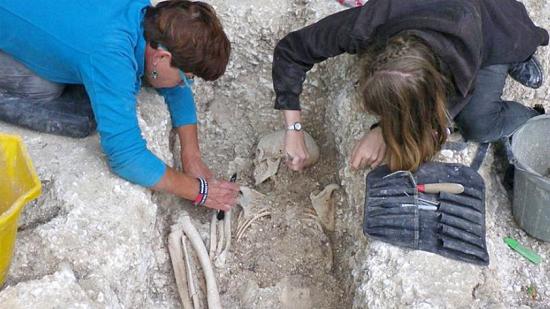Ben Miller
Source - http://www.culture24.org.uk//history-and-heritage/archaeology/art492893-Anglo-Saxon-arthritis-sufferer-graves-swords-found-archaeologists-Barrow-Clump?
A large Anglo-Saxon arthritis sufferer and a spearhead and knife from the deep grave of an important burial have been found at a Neolithic settlement which later became a Bronze Age burial mound and Saxon cemetery

Archaeologists say the discovery of remains in a crouched position is the first of its kind at Barrow Clump, a Scheduled Ancient Monument on Salisbury Plain. A shield boss and the pointed tip of an iron artefact led to a dig archaeologists called “particularly special”.
“The full excavation of the grave exceeded our expectations, with the pointed tip belonging to a sword,” said Angus Forshaw, of Wessex Archaeology.
“This is a particularly rare find and a first for Barrow Clump.
“The condition of the sword was impressive, with the copper alloy fittings from the scabbard surviving in-situ along with an associated bead.
“The mineralised remains alongside the metal suggest that the scabbard was made of wood and leather, with the handle made from horn.
“We will X-ray the sword in order to gather more information on its design and construction.
“Along with the sword and shield boss, the grave contained a spearhead and a knife, making it the most richly furnished male burial on site: the sign of a prestigious individual.”
Saucer brooches, a finger ring and a knife were found among a total of 13 Anglo-Saxon graves. Metal detectorists also unearthed Roman coins, a Parachute Regiment badge from between 1945 and 1952, when the Salisbury Plain Training Area was in use, and two Bronze Age cremation urns.
“Excavation of these showed that both pots had been inverted on burial,” said Forshaw.
“The first of these was fully excavated and lifted on site – a delicate process involving the quadranting of the contents and regular recording.
“This patience was rewarded in revealing coiled decoration on the interior of the vessel.
“Excavation also began on the second of these urned cremation burials, with this vessel being almost complete – a rare discovery that caught everyone’s interest.”
Osteoarchaeologist Jackie McKinley identified one male skeleton as being between 50 and 80 years old.
“The size of the bones clearly indicated that this was a large man, with the areas of muscle attachment to the bone showing that he must have been of muscular build,” said Forshaw.
“On closer inspection it was revealed that he would have suffered from a condition known as Diffuse Idiopathic Skeletal Hyperostosis.
“This leads to ossification of spinal ligaments resulting in a ‘dripped candle wax’ appearance to the spine.
“He was also suffering from arthritis in his neck.”